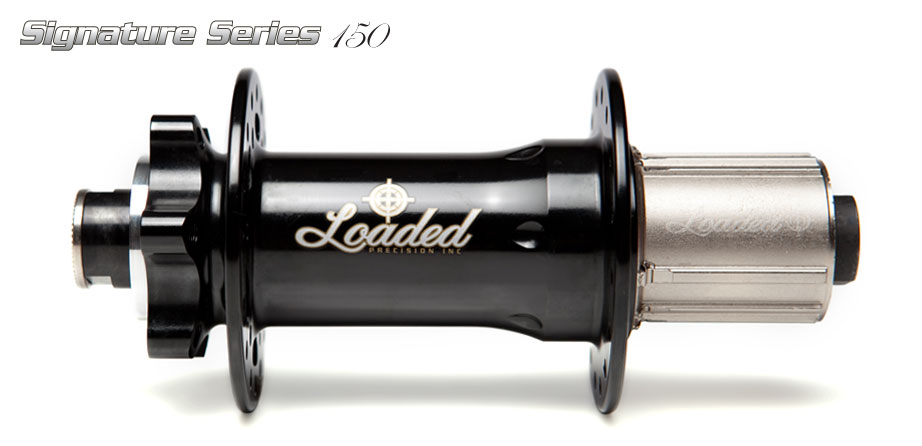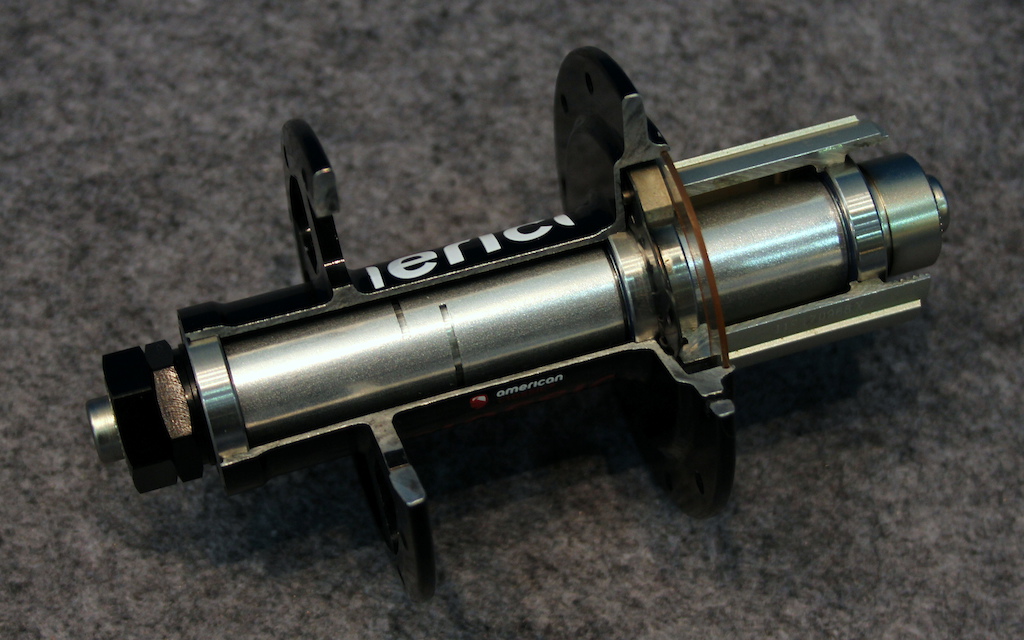- This topic has 21 replies, 12 voices, and was last updated 8 years ago by benpinnick.
-
Them there Hope downhill hubs…
-
sharkattackFull MemberPosted 8 years ago
I’m idly browsing the options for a wheel build on a DH bike so I obviously checked out Hope hubs.
Now, correct me if I’m wrong (as if you won’t anyway) but I thought the entire point of a 150mm rear hub was to increase the distance between the flanges and give a wider base for a stronger build?
Which is why I thought this hub looks really odd with an acre of space between the flange and the disc mount.
I can’t imagine why they’ve done that so is there an actual practical reason for it?
These on the other hand have maximum wideness
Open to other recommendations for some semi-posh, fast DH hubs
ElectricWorryFree MemberPosted 8 years agoI guess the idea is that the spoke lengths for both sides would be equal – giving a better balance of tensions across the wheel….
Looks interesting though. Not sure I’m a fan.
NorthwindFull MemberPosted 8 years agoAs I understand it Hope decided not to bother designing a 150mm hub, they just wanged what’s essentially an integrated spacer onto their 135mm to make it fit.
Jury’s out on whether 150mm was ever actually worth it for performance benefits tbh but this way you get all the drawbacks and no benefit (and some bike manufacturers went bollocks to it, and made 135mm DH bikes.)
PeterPoddyFree MemberPosted 8 years agoI guess the idea is that the spoke lengths for both sides would be equal – giving a better balance of tensions across the wheel….
Phh, well yeah, it might do that. But they still won’t be equal.
THE WHOLE POINT of a wider rear end is stiffness and strength. Wider braced spokes do that, that’s simple logic, as they create a wider based triangle if you like.
Bodging it with a spacer is a cop outmatthew_hFree MemberPosted 8 years agoNot the case at all. The flanges on their 150mm hub are spaced so they both have the same offset from the centreline of the hub meaning that they spoke tensions are pretty much even on both sides (not quite the same as the flanges have differing PCDs). This gives a stronger wheel as both sides of the spokes can be tensioned right up to the rim maximum.
It would actually be detrimental to wheel stiffness to move the NDS flange further out towards the disc mount.
sharkattackFull MemberPosted 8 years agoWhere did that nice blue king hub go?
Accidentally posted a 135 version.
Jury’s out on whether 150mm was ever actually worth it for performance benefits tbh but this way you get all the drawbacks and no benefit
That’s disappointing. I thought Hope were the ones to do everything for a reason and this seems like a copout.
and some bike manufacturers went bollocks to it, and made 135mm DH bikes
Is there anyone except Specialized doing this?
Regardless of the benefits, I’ve got a 150mm frame and I want that sucker stuffed with strongness.
wwaswasFull MemberPosted 8 years agoAmerican Classic have taken the same approach with their Boost 148 hubs;
http://www.pinkbike.com/news/american-classic-taipei-show-2015.html
American Classic have taken a slightly different approach to other manufacturers jumping on the Boost bandwagon. While other brands simply moving front hub flanges outwards 5mm on each side, Shook have added extra 10mm of width to the non-drive side axle, and the flange width hasn’t changed from their regular hubs.This makes for a symmetrical wheel build, which they say is more beneficial in terms of strength and weight than a wider base to the spoke triangle. A symmetrical wheel will have equal spoke tension rather than one side having a higher tension and therefore less pressure on the spokes and eyelets, and the possibility of building a slightly lighter rim. The same theory is applied to the rear hub which adds 6mm to the non-drive side between the flanges and disc mount, not quite achieving symmetry, but close.PeterPoddyFree MemberPosted 8 years agoIt would actually be detrimental to wheel stiffness to move the NDS flange further out towards the disc mount.
Evidence?
sharkattackFull MemberPosted 8 years agoThat sounds right. If the rim on the Hope hub sits right between the flanges with equal spoke sizes then I’m on board. I was just wondering why it ‘looked wrong’ compared to other brands.
bigjimFull MemberPosted 8 years agoYeah even spoke tension is what you want, if it moved even further out the tensions would be even more uneven. If those AC hubs weren’t so expensive I’d like to try them.
breatheeasyFree MemberPosted 8 years agoPhh, well yeah, it might do that. But they still won’t be equal.
THE WHOLE POINT of a wider rear end is stiffness and strength. Wider braced spokes do that, that’s simple logic, as they create a wider based triangle if you like.Don’t forget you’ve got a dirty great cassette on one side of the hub so you can make a ‘nice’ wide triangle with the same angles both sides. Stick the non drive side out too far and then you’d have to have less tension in the spokes on that side otherwise it’d pull the rim across to balance out the tensions. Loose tension on one side is not your friend on a wheel build.
scruffFree MemberPosted 8 years agoAnyone doing 150 hubs with a 7spd Dh carrier? Would give more width both sides of the hub Shirley?
Dark-SideFull MemberPosted 8 years agoI’ve been running Aivee hubs for over a year now, and I’m very impressed. Aaron Gwin rode on the MT3’s in the World Champs.
NewRetroTomFull MemberPosted 8 years agoNorthwind – Member
As I understand it Hope decided not to bother designing a 150mm hub, they just wanged what’s essentially an integrated spacer onto their 135mm to make it fit.What NW has said is not the case:
“Boost
With another standard launched this year we have made hubs compatible with the 110mm front and 148mm rear spacing. To take full advantage of all this new standard can offer we have produced specific hub shells for this wider standard.”From http://www.hopetech.com/eurobike/
As others have said above if you space the non-drive side flange out further from the hub centre you need lower spoke tension on that side. Beyond a certain point even if the drive side spokes are at the tension limit for the rim the non-drive side spokes will be slack enough that they will loosen with use.
benpinnickFull MemberPosted 8 years agoI’d definitely take even spoke tension over a wider flange spacing (rather have both but hey ho). Whats really dumb is 7 speed DH cassettes that use 11speed with freehubs. Surely it would be better to make a smaller FH since we’re making a special 150 hub anyhoo?
sharkattackFull MemberPosted 8 years agoAaron Gwin rode on the MT3’s in the World Champs
When? DT Swiss 240 in all the pics.
I actually have a 240 currently and I just went to examine it. It looks just like the Hope. And the rim is central between the flanges and the spokes are the same length on both sides. Looks perfect to me so it’s okay, I’ll let Hope off the hook! I never noticed it as the disc mounts are much deeper so there’s no big visible gap on the body.
Maybe I’ll treat myself to some purple Pro 2’s after all.
NorthwindFull MemberPosted 8 years agoNewRetroTom – Member
What NW has said is not the case:
Boost and 150mm are not the same hubs. Though it’s interesting that they’ve gone with wider flanges for Boost but never did for 150mm, eh? 😆 No wonder the thread can’t arrive at a concensus if Hope can’t decide themselves.
@sharkattack, there’s been various 135mm dh bikes- Last Herb, Orange 224 Evo, some Scotts and Turners, off the top of my head. Some Radicals maybe? Not sure about that. Orange were class when they switched back to 150mm, they essentially said “135mm/73mm makes more sense, but we’re fed up of people asking us why” 😆
Dark-SideFull MemberPosted 8 years agosharkattack – Member
Aaron Gwin rode on the MT3’s in the World Champs
When? DT Swiss 240 in all the pics.I just went back to check the Facebook post. Aivee have uploaded a number of images of Gwin’s bike with a comment which I thought said he was using Aivee hubs, but on reflection I think it says he is not using their hubs, which is a little strange as a marketing strategy!
You can see the post on their timeline Aivee
benpinnickFull MemberPosted 8 years agoBoost and 150mm are not the same hubs. Though it’s interesting that they’ve gone with wider flanges for Boost but never did for 150mm, eh? No wonder the thread can’t arrive at a concensus if Hope can’t decide themselves.
Different goals mean different approaches. Also as 150 is quite a bit wider than 148 you get a wider ds flange so balancing them is less problematic.
benpinnickFull MemberPosted 8 years agoI think the point of a 150 rear is to allow for an 83mm front more than anything – giving a stronger, stiffer BB area / main pivot. The same thing they did with boost. To run a 10mm wider BB you need to adjust the chainline out more on the rear too, by 5mm. What the cleverer people that worked on the 150 ‘standard’ figured out was that actually you wanted to push it by more than the difference in the BB as 1x chainlines behave differently than 2 or 3 by.
The topic ‘Them there Hope downhill hubs…’ is closed to new replies.




